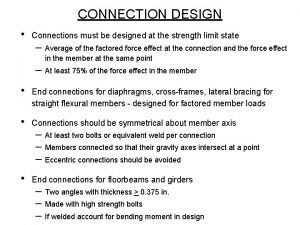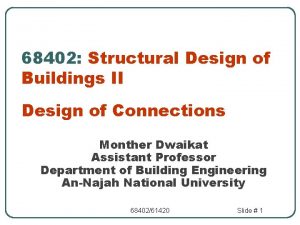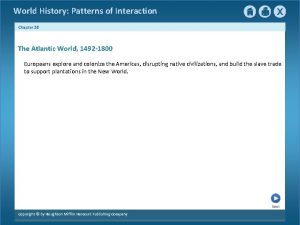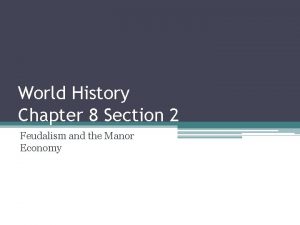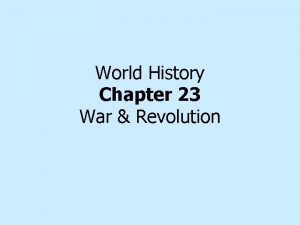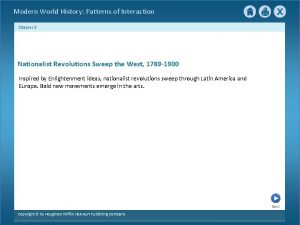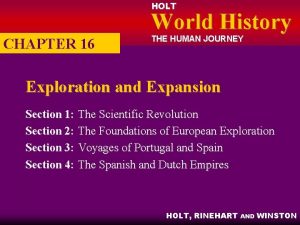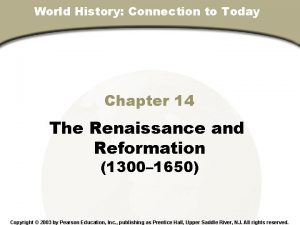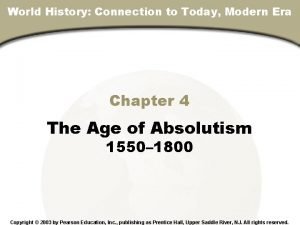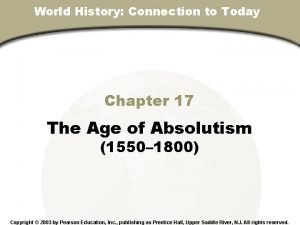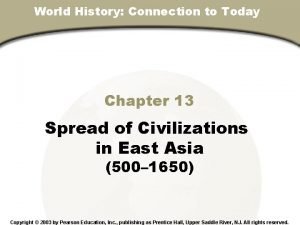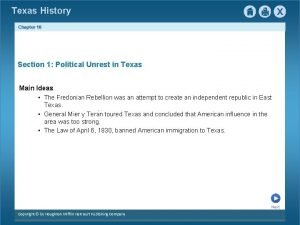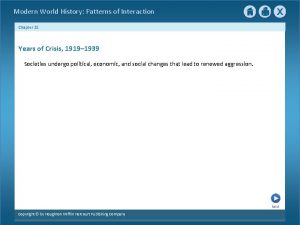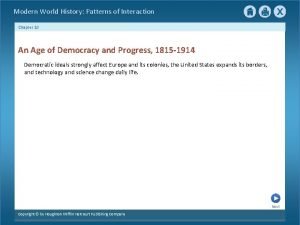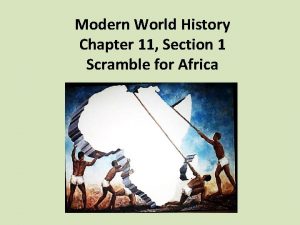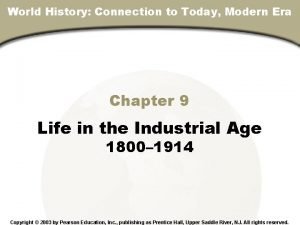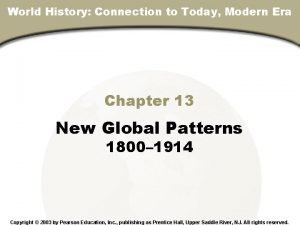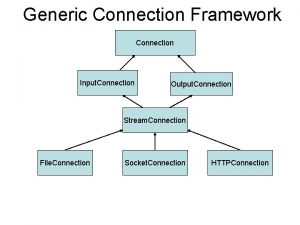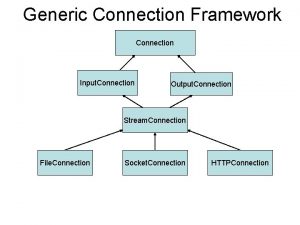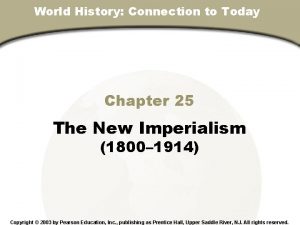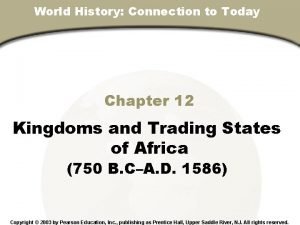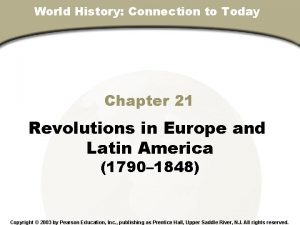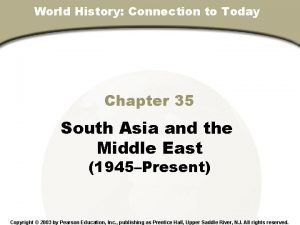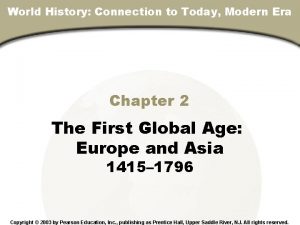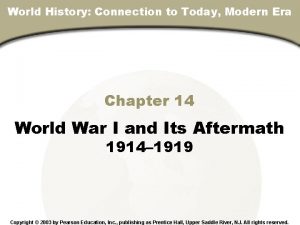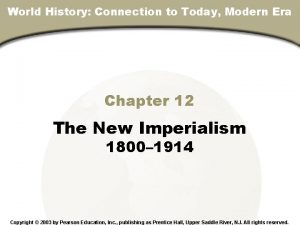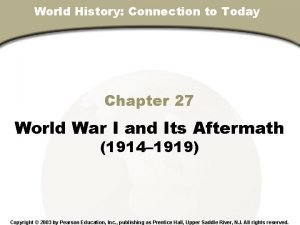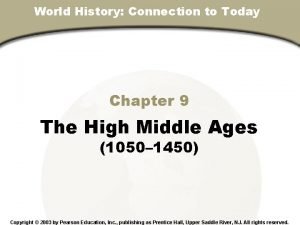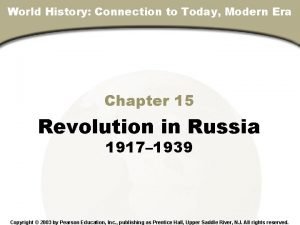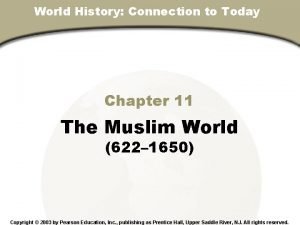World History Connection to Today Chapter 23 Section




































- Slides: 36

World History: Connection to Today Chapter 23, Section Chapter 23 Nationalism Triumphs in Europe (1800– 1914) Copyright © 2003 by Pearson Education, Inc. , publishing as Prentice Hall, Upper Saddle River, NJ. All rights reserved.

World History: Connection to Today Chapter 23, Section Chapter 23: Nationalism Triumphs in Europe (1800– 1914) Section 1: Building a German Nation Section 2: Strengthening Germany Section 3: Unifying Italy Section 4: Nationalism Threatens Old Empires Section 5: Russia: Reform and Reaction Copyright © 2003 by Pearson Education, Inc. , publishing as Prentice Hall, Upper Saddle River, NJ. All rights reserved.

Chapter 23, Section 1 Building a German Nation • What early changes promoted German unity? • How did Bismarck unify Germany? • What was the basic political organization of the new German empire?

Chapter 23, Section 1 Steps Toward German Unity • Between 1807 and 1812, Napoleon made important territorial changes in German-speaking lands. Many Germans resented Napoleon and his changes. As people fought to free their lands from French rule, they began to demand a unified state. • In the 1830 s, Prussia created an economic union called the Zollverein. • In 1848, liberals again demanded German political unity. They offered the throne of a united German state to Frederick William IV of Prussia, but he refused it.

Chapter 23, Section 1 How did Bismarck unify Germany? In 1862, Otto von Bismarck was made chancellor, or prime minister, of Prussia. Within a decade, Bismarck had united the German states under Prussia. • • • Bismarck was a master of Realpolitik, or realistic politics based on the needs of the state. He valued power over principles. Bismarck strengthened the army in preparation for pursuing an aggressive foreign policy. In 1864, Bismarck formed an alliance with Austria. Together, they seized the provinces of Schleswig and Holstein from Denmark and divided up the spoils. In 1866, Bismarck attacked and defeated Austria in the Austro. Prussian War, and then annexed, or took control of, several north German states. Bismarck dissolved the Austrian-led German Confederation and created a new confederation dominated by Prussia. In 1870, Bismarck provoked France into the Franco-Prussian War and quickly claimed victory.

Chapter 23, Section 1 The German Empire William I of Prussia was given the title kaiser, or emperor. In 1871, German nationalists proclaimed the birth of the Second Reich, or empire. Bismarck drafted a constitution with a two-house legislature: • The Bundesrat, or upper house, was appointed by the rulers of the German states. • The Reichstag, or lower house, was elected by universal male suffrage. Because the Bundesrat could veto any decision of the Reichstag, real power remained in the hands of the emperor and his chancellor.

Chapter 23, Section 1 Unification of Germany, 1865– 1871

Chapter 23, Section 1 Assessment Prussia and Austria seized and divided up a) Hanover. b) Schleswig and Holstein. c) Denmark. d) the Holy Roman Empire. Although the legislature of the Second Reich was made up of two houses, real power remained in the hands of a) the Reichstag. b) the emperor and his chancellor. c) the common people. d) individual German states. Want to connect to the World History link for this section? Click Here.

Chapter 23, Section 1 Assessment Prussia and Austria seized and divided up a) Hanover. b) Schleswig and Holstein. c) Denmark. d) the Holy Roman Empire. Although the legislature of the Second Reich was made up of two houses, real power remained in the hands of a) the Reichstag. b) the emperor and his chancellor. c) the common people. d) individual German states. Want to connect to the World History link for this section? Click Here.

Chapter 23, Section 2 Strengthening Germany • What marked Germany as an industrial giant? • Why was Bismarck called the Iron Chancellor? • What policies did Kaiser William II follow?

Chapter 23, Section 2 The German Industrial Giant By the late 1800 s, German chemical and electrical industries were setting the standard worldwide. German shipping was second only to Britain’s among the European powers. Germany possessed several characteristics that made industrialization possible: • Ample iron and coal resources • Disciplined and educated work force • Rapidly growing population In the 1850 s and 1860 s, Germans had founded large companies and built many railroads. German industrialists were the first to see the value of applied science in developing new products such as synthetic chemicals and dyes.

Chapter 23, Section 2 The Iron Chancellor Called the Iron Chancellor, Bismarck applied ruthless methods to achieve his goals. Foreign policy goals: • Bismarck wanted to keep France weak and isolated while building strong links with Austria. • Later, Bismarck competed with Britain for colonies to expand Germany’s overseas empire. Domestic goals: • Bismarck sought to erase local loyalties and crush all opposition to the imperial state. He targeted the Catholic Church and the socialists, both of which he saw as a threat to the new German state.

Chapter 23, Section 2 Kaiser William II When William II came to power, he wanted to put his own stamp on Germany. During his reign, he • asked Bismarck to resign, believing that his right to rule came from God and that “there is only one master in the Reich. ” • resisted efforts to introduce democratic reforms. • provided services, such as programs for social welfare, cheap transportation, and electricity. • spent heavily on the German military machine. • launched an ambitious campaign to expand the German navy and win an overseas empire.

Chapter 23, Section 2 Assessment Which groups did Bismarck view as a threat to the new German state? a) peasants and merchants b) industrialists and Catholics c) Catholics and socialists d) the army and nobles Kaiser William II did which of the following? a) put more power in the hands of Bismarck b) reduced military spending c) introduced democratic reforms d) launched a campaign to win an overseas empire Want to connect to the World History link for this section? Click Here.

Chapter 23, Section 2 Assessment Which groups did Bismarck view as a threat to the new German state? a) peasants and merchants b) industrialists and Catholics c) Catholics and socialists d) the army and nobles Kaiser William II did which of the following? a) put more power in the hands of Bismarck b) reduced military spending c) introduced democratic reforms d) launched a campaign to win an overseas empire Want to connect to the World History link for this section? Click Here.

Chapter 23, Section 3 Unifying Italy • What were the key obstacles to Italian unity? • What roles did Count Camillo Cavour and Giuseppe Garibaldi play in the struggle for Italy? • What challenges faced the new nation of Italy?

Chapter 23, Section 3 Obstacles to Italian Unity For centuries, Italy had been a battleground for ambitious foreign and local princes. Frequent warfare and foreign rule had led people to identify with local regions. The Congress of Vienna divided Italy up among Austrian rulers, Hapsburg monarchs, and a French Bourbon king. Nationalist attempts to expel Austrian forces from northern Italy were repeatedly crushed.

Chapter 23, Section 3 The Struggle for Italy CAVOUR GARIBALDI Prime minister who believed in Realpolitik. Long-time nationalist leader who wanted to create an Italian republic. Wanted to end Austrian power in Italy and annex its provinces of Lombardy and Venetia. Captured Sicily and Naples and turned them over to Victor Emmanuel. Shortly afterward, Victor Emmanuel II was crowned king of Italy. Led Sardinia to provoke a war with Austria. With help from France, Sardinia defeated Austria and annexed Lombardy.

Chapter 23, Section 3 What Challenges Faced the New Nation of Italy? • Italy had no tradition of unity. Strong regional ties left Italy unable to solve critical national issues. • An enormous gap existed between the north, which was richer and had more cities, and the south, which was poor and rural. • Hostility between Italy and the Roman Catholic Church further divided the nation. • In the late 1800 s, unrest increased as radicals on the left struggled against a conservative right.

Chapter 23, Section 3 Unification of Italy, 1858– 1870

Chapter 23, Section 3 Assessment Unified Italy in 1870 included all of the following except a) Sardinia. b) Tuscany. c) Corsica. d) Venetia. Which of the following challenges did the new Italian nation face? a) a gap between the richer north and the poorer south b) inflation c) social problems caused by rapid industrialization d) a gap between the poorer north and the richer south Want to connect to the World History link for this section? Click Here.

Chapter 23, Section 3 Assessment Unified Italy in 1870 included all of the following except a) Sardinia. b) Tuscany. c) Corsica. d) Venetia. Which of the following challenges did the new Italian nation face? a) a gap between the richer north and the poorer south b) inflation c) social problems caused by rapid industrialization d) a gap between the poorer north and the richer south Want to connect to the World History link for this section? Click Here.

Chapter 23, Section 4 Nationalism Threatens Old Empires • How did nationalism contribute to the decline of the Austrian empire? • What were the main characteristics of the Dual Monarchy? • How did the growth of nationalism affect the Balkans?

Chapter 23, Section 4 Decline of the Austrian Empire Austrian rulers upheld conservative goals against liberal forces. Austria, however, could not hold back the changes that were engulfing the rest of Europe. The Hapsburgs presided over a multinational empire, yet continued to ignore the urgent demands of nationalists. After Austria was defeated by France and Sardinia in 1859, Emperor Francis Joseph made some limited reforms. The reforms failed to satisfy the many nationalist groups that wanted self-government.

Chapter 23, Section 4 Dual Monarchy Austria’s defeat in the 1866 war with Prussia brought renewed pressure for change from Hungarians within the empire. This pressure led to the creation of a new political power known as the Dual Monarchy of Austria-Hungary. Under the Dual Monarchy: • Austria and Hungary were separate states. • Francis Joseph ruled both, as emperor of Austria and king of Hungary. • The two states shared ministries of finance, defense, and foreign affairs, but were independent of each other in all other areas.

Chapter 23, Section 4 Balkan Nationalism A complex web of competing interests contributed to a series of crises and wars in the Balkans. Serbia and Greece had won independence in the early 1800 s. However, there were still many Serbs and Greeks living in the Balkans under Ottoman rule. The Ottoman empire was home to other national groups, such as Bulgarians and Romanians. During the 1800 s, various subject people staged revolts against the Ottomans, hoping to set up their own independent states. European powers stepped in to divide up Ottoman lands, ignoring the nationalist goals of various Balkan peoples.

Chapter 23, Section 4 The Balkans, 1878

Chapter 23, Section 4 Assessment The Dual Monarchy governed a) Bulgaria and Romania. b) Austria and Prussia. c) Prussia and Russia. d) Austria and Hungary. The people of the Balkans lived under the rule of a) the Hapsburg empire. b) the Ottoman empire. c) the Second Reich. d) the Holy Roman Empire. Want to connect to the World History link for this section? Click Here.

Chapter 23, Section 4 Assessment The Dual Monarchy governed a) Bulgaria and Romania. b) Austria and Prussia. c) Prussia and Russia. d) Austria and Hungary. The people of the Balkans lived under the rule of a) the Hapsburg empire. b) the Ottoman empire. c) the Second Reich. d) the Holy Roman Empire. Want to connect to the World History link for this section? Click Here.

Chapter 23, Section 5 Russia: Reform and Reaction • How did conditions in Russia affect progress? • Why did czars follow a cycle of absolutism, reform, and reaction? • How did the problems of industrialization contribute to the growing crisis and outbreak of revolution?

Chapter 23, Section 5 How Did Conditions in Russia Affect Progress? By the 1800 s, czars saw the need to modernize but resisted reforms that would undermine their absolute rule. While czars wavered, Russia fell further behind Western Europe in economic and social developments. The rigid social structure was an obstacle to progress: • Landowning nobles dominated society and rejected any change that would threaten their privileges. • The majority of Russians were serfs. Serfdom was inefficient and caused Russia’s economy to remain backward.

Chapter 23, Section 5 Problems of Industrialization Toward the end of the nineteenth century, Russia finally entered the industrial age. • The drive to industrialization increased political and social problems. Nobles and peasants opposed economic growth, fearing the changes brought by the new ways. • Industrialization created social ills as peasants flocked to the cities to work in factories. • Radicals preached revolutionary ideas among the new industrial workers.

Chapter 23, Section 5 Crisis and Revolution War broke out between Russia and Japan. The Russians suffered repeated military defeats. News of the military disasters unleashed pent-up discontent created by years of oppression. The czar’s troops fired on protesters on “Bloody Sunday, ” destroying the people’s trust and faith in the czar. Discontent and revolution spread throughout Russia. Czar Nicholas was forced to announce sweeping reforms. In the October Manifesto, he agreed to summon a Duma, or elected national legislature.

Chapter 23, Section 5 Results of the Revolution • The October Manifesto won over moderates, leaving socialists isolated. • In 1906, the first Duma met, but the czar dissolved it when leaders criticized the government. • Czar Nicholas appointed a conservative prime minister, Peter Stolypin, who instituted arrests, pogroms, and executions. • Stolypin later instituted limited reforms which did not meet the broad needs of most Russians. • By 1914, Russia was still an autocracy, simmering with unrest.

Chapter 23, Section 5 Assessment Why did Russian czars resist reform? a) They thought that industrialization would hurt the peasants. b) They didn’t want to undermine their absolute power. c) They felt there were other ways to create a democratic society. d) They wanted to keep Russia economically backward. What groups in Russia opposed economic growth? a) nobles and peasants b) socialists and radicals c) nobles and socialists d) peasants and businessmen Want to connect to the World History link for this section? Click Here.

Chapter 23, Section 5 Assessment Why did Russian czars resist reform? a) They thought that industrialization would hurt the peasants. b) They didn’t want to undermine their absolute power. c) They felt there were other ways to create a democratic society. d) They wanted to keep Russia economically backward. What groups in Russia opposed economic growth? a) nobles and peasants b) socialists and radicals c) nobles and socialists d) peasants and businessmen Want to connect to the World History link for this section? Click Here.
 Bolted connection
Bolted connection Slip critical connection vs bearing connection
Slip critical connection vs bearing connection Slip critical
Slip critical Text to text connections
Text to text connections Ap world history chapter 25 africa and the atlantic world
Ap world history chapter 25 africa and the atlantic world Chapter 17 section 3 world history
Chapter 17 section 3 world history Chapter 30 section 2 world history
Chapter 30 section 2 world history What was the counter-reformation?
What was the counter-reformation? Chapter 15 section 3 fascism rises in europe
Chapter 15 section 3 fascism rises in europe World history patterns of interaction
World history patterns of interaction World history chapter 8 section 1
World history chapter 8 section 1 Chapter 23 section 3 world history
Chapter 23 section 3 world history Chapter 8 section 1 world history
Chapter 8 section 1 world history Chapter 16 section 1 world history
Chapter 16 section 1 world history Chapter 14 section 1 world history
Chapter 14 section 1 world history Chapter 4 section 4 world history
Chapter 4 section 4 world history Chapter 17 assessment world history
Chapter 17 assessment world history World history chapter 13 section 1
World history chapter 13 section 1 World history chapter 10 section 1
World history chapter 10 section 1 Chapter 15 section 1 postwar uncertainty
Chapter 15 section 1 postwar uncertainty Chapter 10 section 1 world history
Chapter 10 section 1 world history Chapter 11 section 1 the scramble for africa answer key
Chapter 11 section 1 the scramble for africa answer key Chapter 8 section 3 world history
Chapter 8 section 3 world history Chapter 9 section 2 world history
Chapter 9 section 2 world history World history chapter 6 section 1
World history chapter 6 section 1 Chapter 13 section 2 world history
Chapter 13 section 2 world history For today's meeting
For today's meeting Todays class
Todays class Meeting objective
Meeting objective Characteristic of fingerprint
Characteristic of fingerprint Today's lesson or today lesson
Today's lesson or today lesson Today's lesson or today lesson
Today's lesson or today lesson Chapter 13 marketing in today's world worksheet answers
Chapter 13 marketing in today's world worksheet answers Chapter 13 marketing in today's world worksheet answers
Chapter 13 marketing in today's world worksheet answers Chapter 13 marketing in today's world
Chapter 13 marketing in today's world To make place decisions marketers select the right
To make place decisions marketers select the right Bad world tour
Bad world tour
